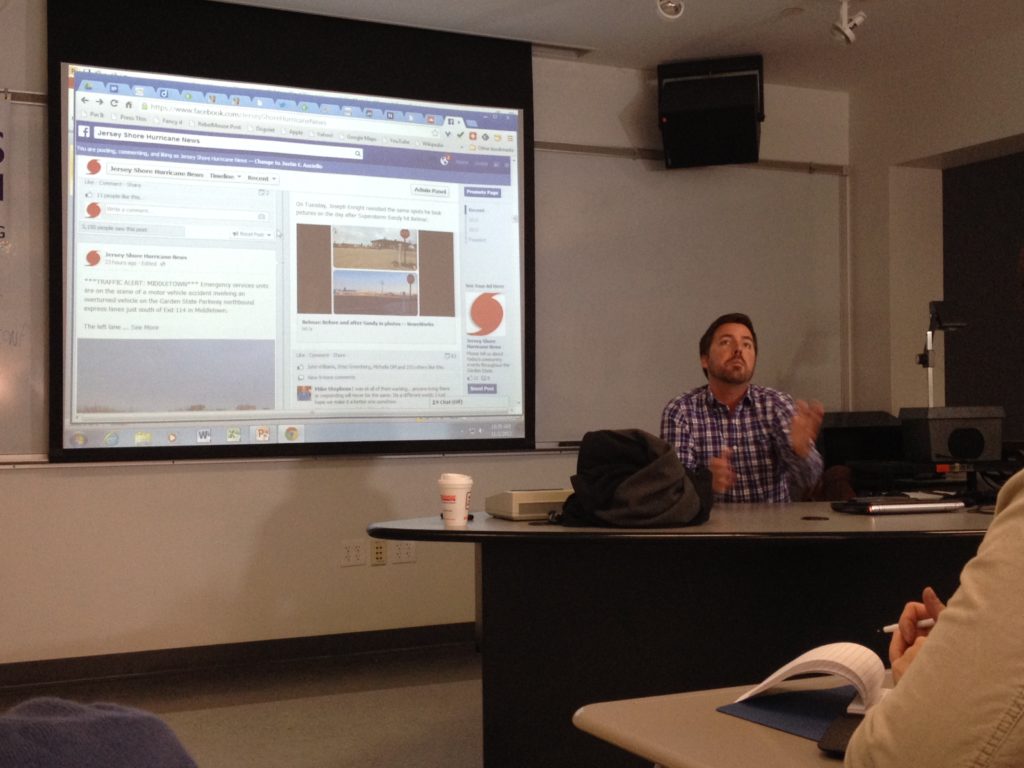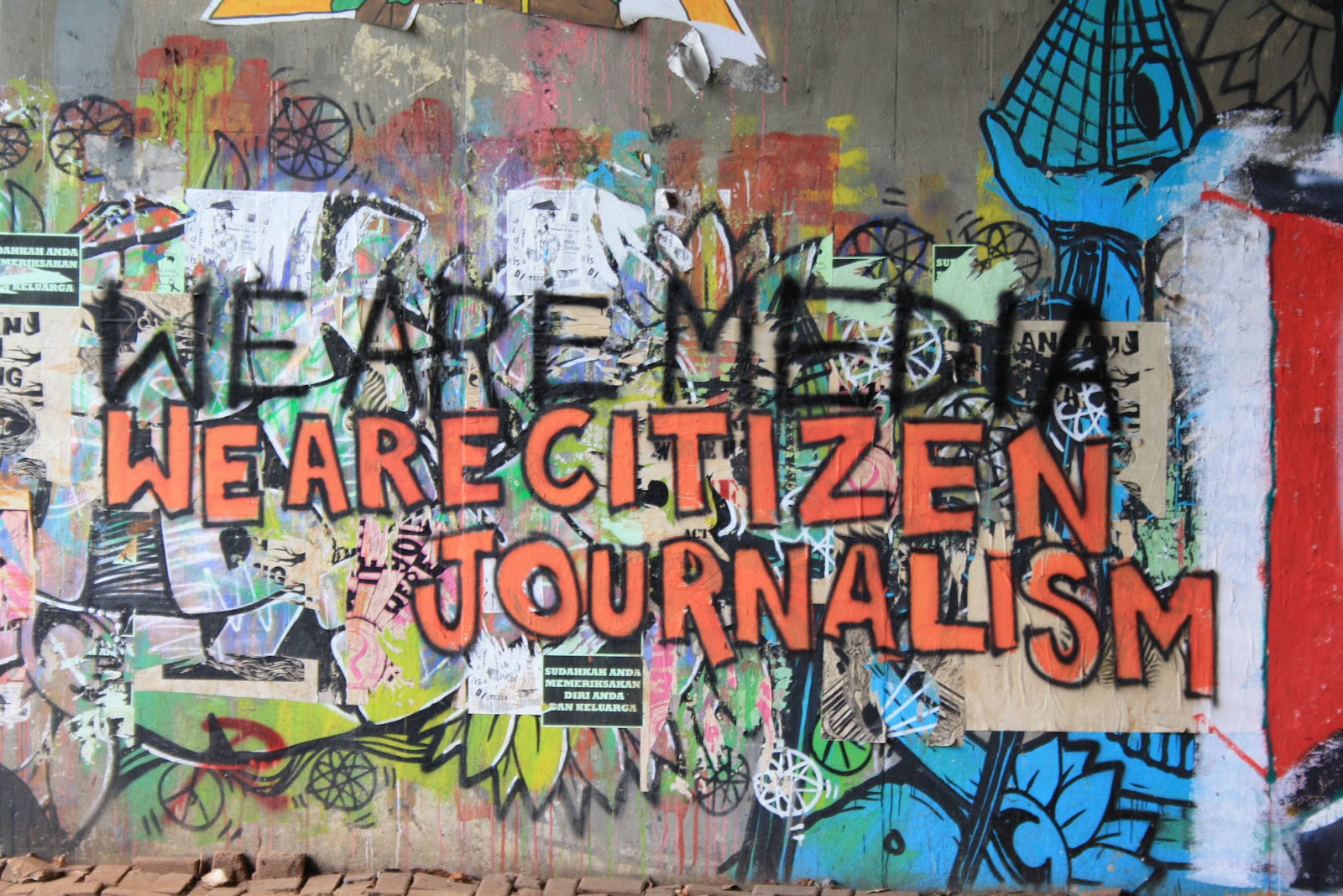*Written by: Tyler Rosen and Rachel Kenny
(The Verge) – Saturday, November 2, The Citizens Campaign, an organization dedicated to encouraging and teaching people to become community reporters, hosted “It Takes a Village: Working Together Online”. The focus of the event was to educate people on the effective tools for participating in citizen journalism in the wake of Hurricane Sandy, such as starting a blog, photo-taking techniques, how to crowd-source news, and mapping a story out.
The event was sponsored by New Jersey Recovery Fund, in addition to Sustainable New Jersey, Clean Ocean Action, Monmouth University, and several others.
It began in ‘The Club’ in Magill Commons, where students and faculty, as well as individuals travelling from various counties in N.J., gathered to hear the welcoming remarks.
Heather Taylor, a member of the Citizens Campaign, delivered the opening address, thanking everyone for coming out early on a Saturday. She then gave a brief overview of what The Citizens Campaign does, including empowering citizens to get results in their community and to take advantage of the Internet to tell their stories. Afterwards, she showed the audience different websites that members of the campaign have created, including the Jersey Shore Hurricane News Facebook page, as well as hyper-local news sites and maps.
Debra Galant, the director of N.J. News Commons, took the stage next and directed everyone to walk over to Plangere Center, where breakout sessions were being held over the next several hours.
The first session, “Setting up Your Own Blog”, was hosted by Galant, along with Kenny Katzgrau, co-founder of Broadstreet Ads. The two of them talked about how they got into blogging and the different steps for someone starting their own blog. One of the main points of the presentation was offering advice for choosing the right blogging software. They explained how sites like Blogger and WordPress are free and easy to use, although there are other paid sites that offer better services, such as providing customer support and registering a custom domain.
The next session, “Video and Photo Journalism”, was hosted by Steve Johnson, who discussed different tools and techniques for taking photos and recording video. He explained the various types of cameras and recording equipment used by journalists, and stated that anyone can take quality photos and videos just by using their phones. He also talked about how to use a microphone when recording someone, and offered tips such as attaching a small microphone to a piece of clothing or a nearby object. Additionally, he discussed the importance of keeping the camera still, and suggested different stands and mounts to use while recording videos.
One of the breakout sessions during the program discussed the topic of crowd sourcing. The presentation was led by Justin Auciello, founder and editor of Jersey Shore Hurricane News, and Adam Glenn, editor for AdaptNY and associate professor at the CUNY Graduate School of Journalism.
Crowd sourcing, according to Auciello, involves filtering through the noise of information from a crowd, and finding the information that applies to what you are trying to accomplish. Jersey Shore Hurricane News is a Facebook-based local news page formed by Auciello in 2011. The page has over 200,000 followers, and relies on contributions from that audience. JSHN is now established as a reputable source.

In the event of the Seaside Boardwalk Fire, Auciello explained, “I was there on the scene… I was essentially not only reporting on Facebook and Twitter, but other news organizations throughout the world were using my information. Essentially, they curated that information from the internet and used it for their purposes.”
During Hurricane Sandy, Auciello had evacuated the shore region, but was still able to report on news using crowd sourcing skills and all available information from other sources, which contained already confirmed information. “I was reporting Sandy from all angles, in real time. I was reporting a story, not even being in that area,” he said.
All of the contributors from different regions of New Jersey make news coverage possible. “I have 200,000 people; they were providing information,” Auciello said. “My job through crowd sourcing, was to go through that, find what was most valuable in real time, confirm it, make sure it’s accurate, and publish it. If I had a standalone, traditional website, I would not have been able to do any of this.”
Crowd sourcing and citizen journalism are all about people using the power of social media to convey information. Community news and communication allows for growth and connection among citizens, which is something other media outlets do not provide.
“You can build a platform like this in your own community very easily. It’s free; it just takes a lot of dedication and a lot of time,” said Auciello.
Glenn took over the presentation to discuss other platforms that can be utilized to share news and information about current events. He briefly mentioned online tools that were less well-known than social media networks, including WordPress, RebelMouse, and DocumentCloud. “They’re free, they’re easy to use, and together you can build a suite of these things to make a one-person operation work,” said Glenn.
Glenn discussed how he provides information using two different methods: curation and documentation. Curation involves filtering through information that has already been reported, while documentation is simply providing primary sources as an additional source.
“The end goal is conversation. If I have curation and documentation and no one is talking about it and sharing it beyond me, then it’s a complete waste of time.”
One tool Glenn explained (a huge time saver in news-gathering), was an RSS feed. Websites like Feedly allow users to collect headlines and articles from saved sources, eliminating the trouble of visiting a multitude of websites for news.
Another tool Glenn advocated was WordPress as a website platform. “WordPress is off-the-rack, ready to use. Very little design and very little HTML is needed. That’s really the beauty of it,” he said.
Glenn discussed RebelMouse, which is a website that creates a social front page by combing content from social media, tweets, statuses, photos and videos, to make an interesting-looking page.
He also briefly talked about DocumentCloud, which is a tool not yet available for public use, but hopefully will be soon. “Document Cloud is a free tool that allows me to put a PDF on my site,” he explained. Users can add comments to the document displayed on the website, allowing open conversation and even more interaction between site visitors.
Another one of the breakout sessions covered how to use a recently developed tool provided by Google: Google Maps Engine. The presentation was led by Stephen Stirling, reporter at The Star-Ledger. Sterling uses data journalism in his own job to create news stories that are appealing to a wide audience.
According to Sterling, data journalism is basically the act of finding stories in numbers and data. “We’re at a point that technology has advanced to a level where you can begin to integrate it in really amazing ways.”
The presentation also included insight on how Google Maps Engine allows anyone with a Google account to create an interactive map in just a few simple steps. Data can be imported to the website, and it will instantly produce a clickable, customizable visual that can be added to a news story, or serve as a lone information source. It is very simple, and a free tool that citizen journalists can utilize to enhance their stories.
After the breakout sessions concluded, program attendees reconvened at the Magill Club for lunch and a group discussion of the presentations. Individuals were divided into groups and discussed what topics they found the most interesting during the sessions, how they were going to utilize the new tools they learned about, and what they expected their personal challenges with citizen journalism to be.
All of the guests at the event left with new knowledge about how they could better be a source of information online when it comes to spreading news throughout the community. With new media, the power of news is in the hands of the people. So in the next Hurricane Sandy, boardwalk fire or scintillating event, be ready to report!




